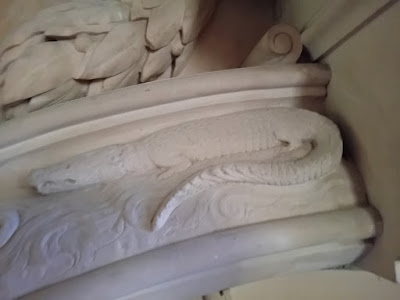The elaborate Popham Memorial in the Church of St John the Baptist in Wellington dates from around 1607. It was made by Cornelius and William Cure, who were master masons to James I. They also made the tomb of Mary, Queen of Scots in Westminster Abbey and the tomb of Bishop Montague in Bath Abbey.
The figures on the memorial are as follows:
- The recumbent effigies of Sir John Popham and his wife Amy Adams are on the table. Sir John is dressed as Lord Chief Justice and he is wearing the collar of S.S. This is an ensign of the office of the Lord Chief Justice.
- Sir John's parents, Alexander Popham and Joan Stradling, are shown kneeling at the west end of the memorial.
- Sir Francis Popham, who was the only son of Sir John, is shown kneeling with his wife, Anne Dudley at the east end.
- The six daughters of Sir John and three ladies' maids are on the south side
- The sons and daughters of Sir Francis Popham are on the north side
Sir John Popham was Speaker of the House of Commons 1581-1583, Attorney General 1581-1592 and Lord Chief Justice of England 1592-1607. He was involved in the trial of Mary, Queen of Scots at Fotheringay Castle in 1587, which resulted in her execution. He presided over the trials of Sir Walter Raleigh in 1603 and the Gunpowder Plot conspirators in 1606.
Sir John Popham married Amy Adams of Castleton in Glamorgan in around 1556 and they had one son (Francis) and six daughters. Amy inherited property from her father, Hugh Adams. Sir John inherited land in Bridgwater and elsewhere from his father. Sir John became a wealthy man and bought estates at Publow near Keynsham, Littlecote in Wiltshire and Hemyock Castle in Devon.
Sir John Popham built a new mansion for himself in Wellington, but this was destroyed during the English Civil War. The mansion was located to the north of Mantle Street and the site is now playing fields used by Wellington AFC and Wellington Cricket Club .
Sir John Popham endowed almhouses in Mantle Street, Wellington in 1606. These were rebuilt in 1833 and converted into Sir John Fisher Catholic Church in 1936.
Peter Blundell died in 1601 and in his will he asked Sir John Popham to establish a free grammar school in Tiverton with his bequest of £20,000. The school opened in 1604 and is still in existence today.
Sir John Popham died in Wellington on 10th June 1607 and was buried in St John the Baptist's Church in Wellington.










